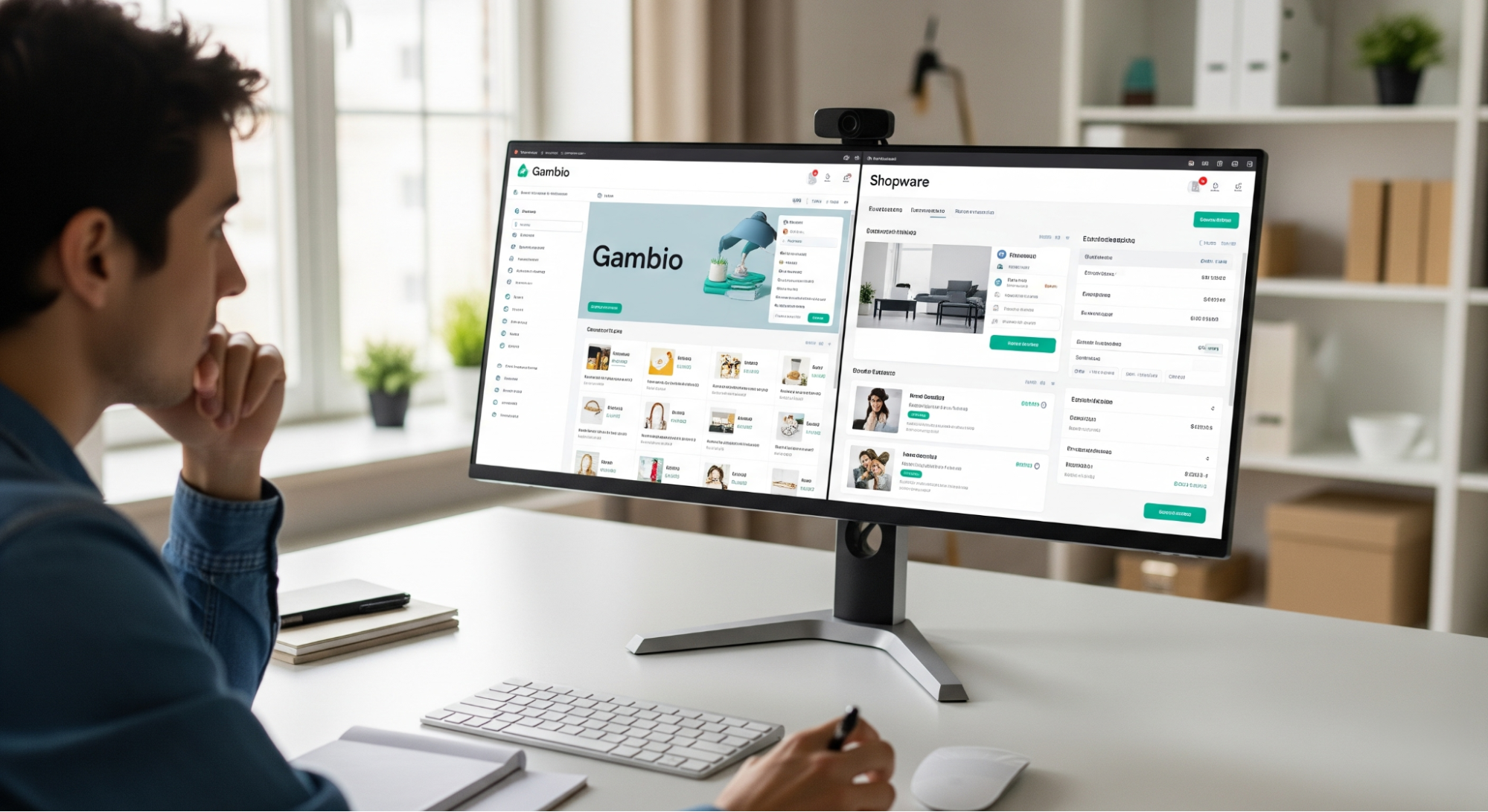When businesses in Germany and across Europe start weighing their options for an online store, the comparison often circles back to Gambio vs Shopware. Both are German-built platforms, but they stand for very different approaches to eCommerce.
Gambio has carved out its place as an affordable, straightforward option for merchants who want to get online quickly without excessive setup. Shopware, on the other hand, is built with growth, flexibility, and advanced business models in mind, making it a leading choice for companies that see their online store as a long-term growth engine rather than just a sales channel.
This guide compares Gambio and Shopware in practical terms, like what each platform does well, where each one stops being suitable, and how to choose the right platform for the next stage of your store. No marketing spin. Just the reasons you’ll want one or the other.
What is Shopware?
Shopware is a German-built eCommerce platform designed for merchants who want flexibility and growth potential. If you’re asking what is Shopware, think of it as a platform that scales. It supports small shops that plan to grow, and it’s trusted by mid-market and larger businesses for complex use cases. Shopware puts more control in the hands of developers and merchants who want to shape their storefront, integrations, and customer experience rather than rely solely on pre-packed templates.
Shopware offers a modular architecture, a strong plugin marketplace, and capabilities that suit B2B and international commerce. Many stores work with a shopware agency to implement custom themes, integrations and B2B workflows, that’s common if you need advanced features or bespoke designs.
What is Gambio?
So, what is Gambio? Gambio is a straightforward, German-focused eCommerce system built for merchants who want to launch quickly without heavy upfront development. It’s practical and geared toward store owners who prefer things that “just work”, meaning out-of-the-box templates, pre-configured payment and shipping connectors, and a user interface that makes everyday operations simple.
Where Shopware aims for flexibility and scale, Gambio aims for speed and low friction. That’s its core selling point: less complexity, fewer choices to make during setup, and a lower cost of entry.
What are the Target Audiences and Use Cases of Gambio and Shopware
Both platforms work for online stores, but their sweet spots differ.
Shopware’s ideal audience includes merchants who want long-term growth, complex pricing models, or B2B features. If you expect to expand internationally, run large catalogs, or need specialized integrations (PIMs, ERP, custom APIs), Shopware is built with those use cases in mind.
Gambio targets small to medium merchants who value simplicity. It’s a good fit for local retailers, single-brand shops, or stores that want a reliable online presence without investing heavily in custom development. If you want a fast launch and predictable costs, Gambio answers that need well.
When evaluating gambio vs shopware, think less about features on paper and more about the problem you need to solve today and the one you expect in 12–36 months. That perspective cuts through the marketing noise.
Gambio vs Shopware: A Detailed Comparison
Pricing Comparison: Gambio vs Shopware – Which Platform Offers Better Value?
Cost matters, and how you measure “value” should change with your goals.
Gambio generally offers a lower upfront cost. Licenses and hosting options are created to keep the entry barrier small. You’ll pay less for setup and you’ll likely need fewer custom builds for a functional store.
Shopware has more licensing tiers. You can start with a free or low-cost edition, but unlocking premium features, official support, and enterprise-grade performance requires higher investment. That upfront investment often becomes cost-effective if your business needs scalability, advanced integrations, or expert-level optimization.
Bottom line, Gambio is better if your priority is low cost and speed. Shopware is better if you value future-proofing and are willing to invest in growth.
Market Share and Popularity: Gambio vs Shopware
Shopware has broader recognition, especially across European markets. It’s commonly used by agencies and larger merchants, and its ecosystem (plugins, developer resources, agency partners) is more mature.
Gambio remains popular in Germany for small and medium merchants because it’s simple and reliable. It doesn’t have the same global market share as Shopware, but it serves its niche well.
Feature Comparison: Key Features of Gambio and Shopware
Shopware’s feature set emphasizes extensibility: an API-first approach, a rich plugin marketplace, advanced promotional engines, and an architecture that supports headless commerce. It’s built to integrate with external systems and to handle complex storefront logic.
Gambio focuses on practicality: common payment providers, shipping connectors, and templates are pre-integrated. It gives you what you need to run an online shop without a long list of decisions.
Both platforms cover the basics (product management, categories, checkout), but Shopware dives deeper where customization and advanced workflows matter.
User-Friendliness and Usability: Which Platform is Easier to Use?
Gambio is simpler for a shop owner who wants to manage product listings, orders, and promotions without technical overhead. The admin is straightforward and predictable.
Shopware has more features and therefore a steeper learning curve. For merchants who are comfortable with a bit of complexity, or who partner with a developer or a shopware agency, that learning curve pays off in capability.
Customization and Flexibility: Which Platform Offers Greater Adaptability?
If you want to craft unique shopping experiences, Shopware wins. You can build custom storefronts, leverage headless setups, and implement tailored checkout flows or multichannel strategies. This makes Shopware suitable for stores that want to stand out and evolve functionally over time.
Gambio is less flexible but more opinionated — which can be good if you prefer a guided experience. If customization needs are modest, you’ll be fine; if you anticipate bespoke features, Gambio will become limiting.
Performance and Speed: Gambio vs Shopware – Which Platform is Faster and More Reliable?
Performance depends on hosting, configuration, and how your store is built. Out of the box, Shopware can be optimized extensively for speed and caching, making it reliable under load if configured correctly. For larger catalogs and high traffic spikes, Shopware’s architecture gives more options to tune performance.
Gambio performs well for small to medium stores on standard hosting. As traffic and catalog size grow, it becomes harder to tune performance without deeper changes or more robust hosting.
Security Features: Which Platform Offers Better Data Protection?
Both platforms adhere to EU data protection standards and provide standard security features like SSL support and secure checkout. Shopware tends to push regular security updates and offers more enterprise-grade configuration for hardening stores. Gambio is secure for typical use, but enterprises often prefer the additional controls and compliance support Shopware provides.
SEO and Marketing Tools: Gambio vs Shopware – Which Platform Supports Growth More Effectively?
Search engine visibility is a long game. Shopware offers more advanced SEO tools and integrations that help when you scale: structured data, SEO-friendly routing, and deeper control over metadata and content components. It also supports better marketing automation and third-party marketing integrations.
Gambio covers basic SEO needs: metadata, sitemaps, and out-of-the-box settings that make small stores discoverable. If you want to run advanced content-driven campaigns or sophisticated SEO strategies, Shopware gives you more power.
Backup and Disaster Recovery: How Secure Are Your Data and Operations?
Backup strategies depend on your hosting and operations. Shopware’s enterprise users often adopt managed hosting with automated backups, staging environments, and stricter recovery options. Gambio stores can be backed up reliably, but you’ll rely more on your hosting provider for recovery workflows.
Data Protection and Compliance: Which Platform is More Secure for Personal Data?
Both platforms are used by German merchants and support GDPR compliance. Shopware typically provides more enterprise-level features — for example, audit trails and advanced permissioning — which help larger teams maintain compliance at scale.
B2B Capabilities: Which Platform is Best for Complex Business Models?
For B2B use cases — customer-specific pricing, punchout catalogs, tiered pricing, and large-order workflows — Shopware is the stronger option. It’s built to support complex B2B models and integrates well into ERP and procurement systems.
Gambio is primarily B2C-focused; while it can handle some larger orders, it lacks the built-in B2B depth that many companies need.
Gambio vs Shopware: Advantages and Disadvantages of Each Platform
Here’s the practical trade-off without marketing fluff: Shopware gives you flexibility, scalability, and advanced features — at a higher cost and with more complexity. Gambio gives you speed of launch, predictable costs, and simplicity — at the expense of scalability and customization.
If your priority is to keep operations lean and simple for a small catalog, choose Gambio. If you’re building a business that intends to scale, enter new markets, or run complex promotions and integrations, Shopware is the safer long-term investment.
Support and Community: Gambio vs Shopware

Support matters because problems happen. Shopware’s community and third-party ecosystem are larger; you’ll find more plugins, consultants, and documented solutions. That means faster problem-solving and more options when you need to extend your store.
Gambio’s support is more focused and localized. For small shops operating primarily in Germany, this can be sufficient and even preferable. But as needs grow, the wider Shopware community becomes an advantage.
Gambio vs Shopware: Which platform is better?
There’s no one-size-fits-all answer. The right choice depends on your immediate needs and your roadmap.
If you want a quick, low-cost store and your catalog and workflows are simple, Gambio is a practical tool. If your plan includes expansion, complex pricing, B2B contracts, or high traffic, Shopware is the platform that will avoid painful replatforming later.
When you weigh gambio vs shopware, focus on these questions: How complex is your catalog? Will you need B2B features? Do you expect international growth? How much budget do you have for development and optimization? Honest answers to those will point you to the right platform.
Closing thoughts — practical advice
If you’re deciding today, don’t let feature lists alone drive your choice. Pick the platform that matches the next 12–36 months of your business.
If you plan to keep your store small, stay local, and minimize complexity, choose the faster path: Gambio. If your goal is growth, international reach, complex business models, or B2B commerce, invest in Shopware and the processes around it — implementation, optimization, and a partner (for example, a shopware agency) who knows how to extract value from the platform.
When comparing shopware vs gambio or gambio vs shopware, think in timelines: immediate needs (0–12 months) vs. future needs (12–36 months). That simple frame will guide a pragmatic choice and reduce the chance you’ll outgrow your decision in a year.








